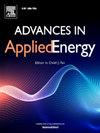Ensemble learning framework for radiative cooling coatings in China’s buildings
IF 13.8
Q1 ENERGY & FUELS
引用次数: 0
Abstract
Radiative cooling (RC) coatings have emerged as a promising strategy to mitigate the urban heat island effect and improve energy performance in residential buildings. However, their effect varies significantly across different climate zones and urban configurations, underscoring the need for targeted deployment strategies. In this study, an ensemble learning framework was developed by integrating the urban canopy model with the building energy model to predict the energy performance of RC coatings on residential buildings throughout China. A dataset of 5080 cases was generated, and CatBoost demonstrated excellent predictive accuracy (R2 = 0.948–0.989). SHapley Additive exPlanations analysis identified longwave radiation and building geometry as the most influential factors affecting RC coating energy performance. The trained prediction model was further applied to evaluate six representative cities across diverse climate zones, for community-level evaluation. Additionally, national-scale predictions were conducted by the framework, using simulations of 111 cities, showing RC coatings are most effective in climate zones with hot summer and warm winter, with maximum annual electricity savings of approximately 50 MWh and maximum carbon emission reductions of around 20 kg·m-2 per year in a hypothetical residential neighborhood. In contrast, their benefits are more limited in cold climate zones due to increased heating demand. These findings provide an effective framework for optimizing RC coating deployment strategies under varying climatic conditions. Furthermore, the framework holds the potential to expand these analyses globally, enabling the evaluation of RC coatings across diverse building types and regions to support worldwide energy and carbon reduction goals.
中国建筑辐射冷却涂料的集成学习框架
辐射冷却(RC)涂料已成为一种有前途的策略,以减轻城市热岛效应和提高能源性能的住宅建筑。然而,它们的影响在不同的气候带和城市配置中差异很大,这强调了有针对性的部署策略的必要性。在本研究中,通过将城市顶棚模型与建筑能耗模型相结合,建立了一个集成学习框架来预测中国住宅RC涂料的能耗性能。生成了5080个病例的数据集,CatBoost显示出良好的预测准确率(R2 = 0.948-0.989)。SHapley加性解释分析发现,长波辐射和建筑几何是影响RC涂层节能性能的最大因素。将训练后的预测模型应用于6个不同气候带的代表性城市,进行社区层面的评价。此外,通过对111个城市的模拟,该框架进行了全国范围的预测,表明RC涂料在夏季炎热和冬季温暖的气候区最为有效,在一个假设的居民区,每年最多可节省约50兆瓦时的电力,最多可减少约20公斤·m-2的碳排放。相比之下,由于供暖需求增加,它们的效益在寒冷气候地区更为有限。这些发现为在不同气候条件下优化RC涂层部署策略提供了有效的框架。此外,该框架具有在全球范围内扩展这些分析的潜力,能够对不同建筑类型和地区的RC涂料进行评估,以支持全球能源和碳减排目标。
本文章由计算机程序翻译,如有差异,请以英文原文为准。
求助全文
约1分钟内获得全文
求助全文

 求助内容:
求助内容: 应助结果提醒方式:
应助结果提醒方式:


